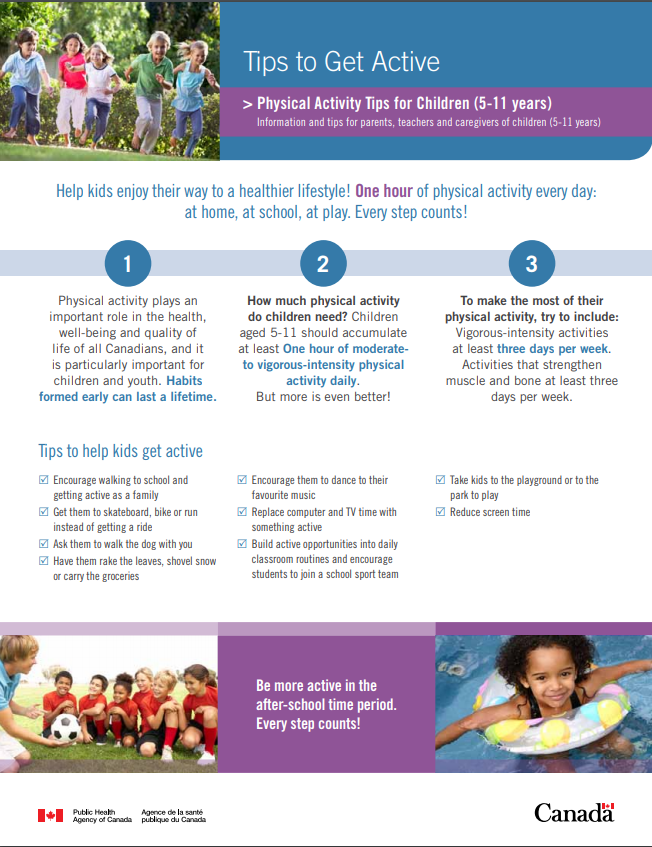Physical Activity Tips for Children (5-11 years)

Download the alternative format
(PDF Document - 355 KB - 2 pages)
Tips to Get Active
Information and tips for parents, teachers and caregivers of children (5-11 years)
Help kids enjoy their way to a healthier lifestyle! One hour of physical activity every day: at home, at school, at play. Every step counts!
- Physical activity plays an important role in the health, well-being and quality of life of all Canadians, and it is particularly important for children and youth. Habits formed early can last a lifetime.
- How much physical activity do children need? Children aged 5-11 should accumulate at least One hour of moderate to vigorous-intensity physical activity daily. But more is even better!
- To make the most of their physical activity, try to include: Vigorous-intensity activities at least three days per week. Activities that strengthen muscle and bone at least three days per week.
Tips to help kids get active
- Encourage walking to school and getting active as a family
- Get them to skateboard, bike or run instead of getting a ride
- Ask them to walk the dog with you
- Have them rake the leaves, shovel snow or carry the groceries
- Encourage them to dance to their favourite music
- Replace computer and TV time with something active
- Build active opportunities into daily classroom routines and encourage students to join a school sport team
- Take kids to the playground or to the park to play
- Reduce screen time
Be more active in the after-school time period. Every step counts!
Health Benefits
- Opportunities for socializing
- Improve fitness
- Increased concentration
- Better academic scores
- Stronger heart, bones and healthier muscles
- Healthy growth and development
- Improved self-esteem
- Better posture and balance
- Lower stress
More physical activity provides health benefits. Encourage children to move more as part of a healthy lifestyle.
What is moderate aerobic activity?
Moderate-intensity aerobic activity makes you breathe harder and your heart beat faster. You should be able to talk, but not sing.
- Examples of moderate-intensity physical activity include walking quickly, skating, bike riding and skateboarding.
What is vigorous aerobic activity?
With vigorous-intensity aerobic activity, your heart rate will increase even more and you will not be able to say more than a few words without catching a breath.
- Examples of vigorous activity include running, basketball, soccer and cross-country skiing.
What are strengthening activities?
Muscle-strengthening activities build up your muscles. With bone-strengthening activities, muscles push and pull against bones helping make them stronger.
- For children, climbing and swinging on playground equipment is an example of a muscle strengthening activity.
- Examples of bone-strengthening activities include running, walking, and jumping rope.
Combine aerobic and strengthening activities
To achieve health benefits, children need to do both aerobic and strengthening activities. Aerobic activities result in faster breathing, a warmer feeling and an increased heart rate. Strengthening activities build muscles and bones.
Get them active after school
After school is a great time to be physically active. Suggest activities other than TV/computer. Sign up for active programs, and if possible find active ways to get home from school. Make time to be active every day.
Canadian Physical Activity Guidelines were developed by the Canadian Society for Exercise Physiology.